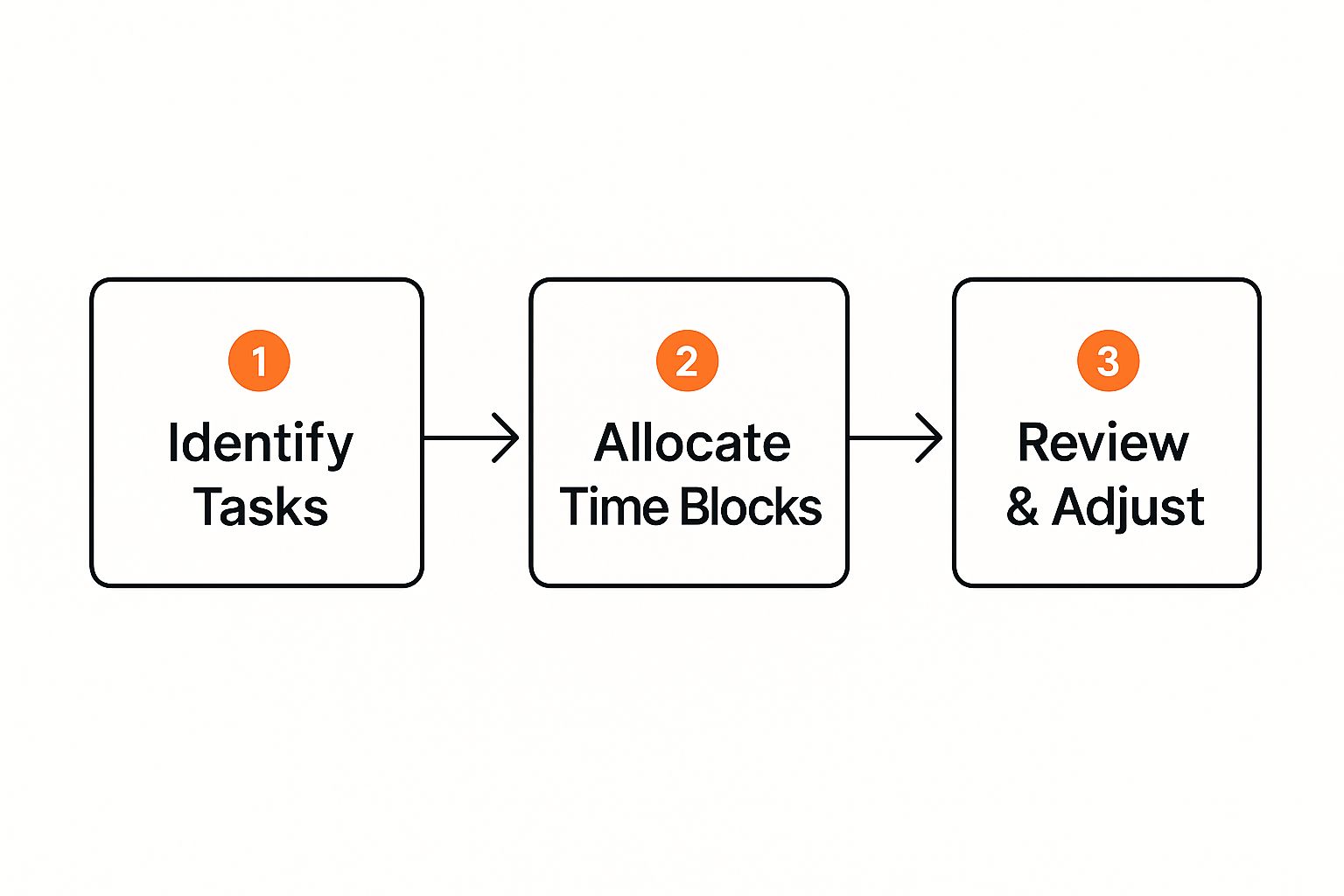For an entrepreneur, managing your time isn't some nice-to-have skill you learn from a productivity guru. It's a straight-up survival strategy. We're talking about managing your energy, your focus, and the brutal reality of opportunity cost. To succeed, you have to ditch the generic to-do lists and build a system that channels your precious few hours into what actually makes money and drives growth.
Why Your Current Time Management System Is Failing You
Let's get real for a second. Most time management advice feels like it was written for a corporate middle manager, not a founder in the trenches. The average entrepreneur's day is pure chaos—a relentless cycle of putting out fires, chasing down new leads, and trying to carve out a few minutes to actually build the business. You aren't just managing tasks; you're managing constant, gut-wrenching uncertainty.

Ultimately, effective time management for entrepreneurs is about building a framework for survival and, eventually, strategic growth. It demands a ruthless, unapologetic focus on what truly matters. This guide is designed to show you exactly how to ensure your most limited asset—your time—is invested in activities that deliver the highest possible return.
Time for a Ruthless Audit: Where Is Your Energy Really Going?
Before you can start optimizing anything, you have to get brutally honest about where your time and energy are disappearing. Most founders I know think they have a good handle on their day, but the hard data almost always tells a different, often shocking, story. This isn't about micromanaging your life; it's about running a diagnostic to uncover the hidden costs of your current habits.

The first step is a simple, one-week audit. You don’t need anything fancy. While tools like Toggl or Clockify are great, a basic spreadsheet will do the trick. Just log every task and, crucially, assign it to a specific category.
Setting Up Your Audit Categories
The real magic of a useful time audit lies in the categories you create. Vague labels like "work" are completely useless here. You need to create buckets that reflect the different gears you shift into while building your business.
Here are a few to get you started:
- Revenue-Generating Work: These are the activities with a direct line to cash. Think sales calls, product demos, closing deals, and any paid client work. If it makes money now, it goes here.
- Strategic Growth: This is the high-leverage stuff that builds future value. We're talking about customer discovery, new product development, serious market research, and forging key partnerships.
- Operational Drag: All that necessary but low-value admin work that just has to get done. This is your invoicing, endless scheduling, and most of that reactive email you deal with.
- Hidden Time Sinks: Be honest with yourself. This category is for activities that feel productive but deliver close to zero real return. It’s the endless social media scrolling, obsessively tweaking website colors, or sitting in on meetings you know are going nowhere.
Just one week of this will give you an eye-opening map of your time. The results can be uncomfortable, but they're always enlightening. It's not uncommon for founders to discover that less than 20% of their week is spent on actual revenue or strategic growth.
I once worked with a founder who was floored to discover he spent 30% of his week—a full day and a half—on manual customer support that could have been handled with better documentation or a simple chatbot. That’s 60 hours a month just gone.
This kind of raw data isn't meant to make you feel bad. It's leverage. It’s the essential first step to reclaiming your focus and getting back to the work that matters.
For indie hackers and solopreneurs, that "Strategic Growth" bucket often means hunting for real user pain points to solve. The problem is, spending hours on Reddit for "research" can quickly turn into a massive time sink. This is where you need a more focused approach. A tool like ProblemSifter was built for this exact scenario. It combs through Reddit to identify real, unfiltered problems for you, turning aimless browsing into a curated list of opportunities. Unlike other tools, ProblemSifter doesn’t just suggest ideas—it connects you to the exact Reddit users asking for them. This transforms a potential time-waster into a highly efficient growth activity, making sure you spend your creative energy on problems that already have an audience.
Focusing on Work That Actually Moves the Needle
Let's be honest. The single biggest time-waster for any entrepreneur isn't checking email or scrolling through social media feeds. It's the silent killer: meticulously building something that absolutely nobody wants. This is where prioritization becomes less of a productivity hack and more of your ultimate superpower.
You can forget generic frameworks like the Eisenhower Matrix, which tends to treat every "important" task with the same weight. As a founder, your most crucial work is always discovering and solving real, nagging customer pain points. Every single hour you spend guessing is an hour you can never get back. The goal is to evolve from a reactive, firefighting to-do list to a proactive, evidence-based roadmap. This means your top priority is always aligning your precious development time with a pre-vetted market need.
This simple flowchart lays out a basic workflow for zeroing in on high-impact tasks, blocking out your time, and consistently circling back to review your progress.

What this really shows is that smart time management isn't a "set it and forget it" system. It’s a continuous loop of assessing what you know, making adjustments, and learning from new information as it comes in.
From Guesswork to Validated Problems
So, how do you actually find these needle-moving problems without sinking weeks into tedious manual research? For indie hackers and solopreneurs, the answer is usually hiding in plain sight—in the online communities where your potential customers gather to complain, ask for help, and vent their frustrations.
Reddit is an absolute goldmine for this kind of raw insight, but manually sifting through it is a classic time sink.
This is where a targeted tool makes all the difference. Instead of just browsing aimlessly, you can use a service like ProblemSifter to tap directly into unfiltered conversations happening in the subreddits that matter to you.
Imagine finding ten people in r/SaaS actively discussing a workflow gap that your product idea could solve perfectly. That’s not just an idea anymore; it's a validated market signal that comes with a built-in list of your first potential users.
Unlike other tools that spit out generic ideas, ProblemSifter connects you directly to the Reddit users asking for solutions. It gives you the original post and the usernames of people expressing that specific pain point, creating a direct line for both customer discovery and targeted outreach. This approach transforms time management from a daily chore into a strategic weapon.
To really dig into this, check out our guide on collecting user feedback to see how these initial conversations can shape your entire product strategy.
The Financial Sense of Smart Prioritization
This isn't just about saving time; it's a calculated business decision. A tool like ProblemSifter, for example, offers lifetime access for a one-time fee of just $49 for one subreddit or $99 for three. There are no recurring subscriptions or hidden costs to worry about. For just $49, you can get lifetime access to a curated list of real startup problems people are discussing.
When you weigh that small investment against the months of development time you could burn building an unvalidated feature, the return on investment is massive. This is the very essence of effective time management for entrepreneurs: spending a little upfront to ensure your most valuable asset—your time—is spent on work that actually moves the needle.
Building Your Personal Productivity Tech Stack
Once you’ve locked in on validated problems, it’s time to build a tech stack that actually buys back your time. The right tools do more than just keep you organized—they create real leverage. They automate the grunt work and free you up to think, create, and connect with customers. Think of it as hiring a small team of digital assistants who work around the clock.
For most entrepreneurs, this stack usually covers a few key areas. You have your project management systems like Trello or Asana to bring some order to the chaos. Then there are automation powerhouses like Zapier that can stitch your apps together and eliminate hours of mind-numbing data entry.
But for indie hackers and solopreneurs, one of the biggest time-saving opportunities lies in customer insight and idea validation. Get this right, and you've already won half the battle.
From Manual Research to Automated Insight
We've all been there—spending weeks digging through forums and social media, hoping to stumble upon a brilliant startup idea. It feels productive, but honestly, the return on that time is often terrible. A specialized tool can completely flip that script.
This is exactly where a tool like ProblemSifter comes in. It’s built to shortcut that painful, months-long process of finding a business idea that people actually want. It does this by pinpointing real, unfiltered problems people are actively discussing on Reddit. You’re no longer guessing what the market needs; you’re getting a direct feed of customer pain points.
The real magic of ProblemSifter is that it doesn’t just show you ideas—it connects you to the specific Reddit users who are asking for a solution. This lets you jump straight from ideation to targeted outreach, cutting out all the guesswork in between.
This approach ensures your most valuable, high-energy hours are spent building something with a ready-made audience.
Investing in Efficiency Without Breaking the Bank
Building a solid tech stack doesn't mean you have to saddle your business with a dozen pricey monthly subscriptions. The goal is to find tools that deliver a massive return on your investment, especially your investment of time.
Many modern tools, particularly in the AI space, are designed to save you a quantifiable number of hours each week. A recent survey of small business owners found that entrepreneurs using AI tools saved an average of six hours per week. That’s over 310 hours a year—a huge advantage when you're just starting out. You can dig deeper into how entrepreneurs are using AI for work-life balance in this Adobe report.
This is why ProblemSifter’s pricing is so compelling for founders on a budget. You get lifetime access to a constantly updated list of real startup problems for a single, one-time payment.
- Lifetime access for 1 subreddit: $49
- Lifetime access for 3 subreddits: $99
No subscriptions, no hidden fees. When you weigh that small, one-off cost against the massive potential waste of building a product nobody wants, it becomes a no-brainer. This isn't just another expense; it’s an investment in making sure your time counts.
To give you a clearer picture, here’s a look at some of the essential tools that can help you reclaim your time.
Time-Saving Tools for Modern Entrepreneurs
This table highlights some essential tools that help entrepreneurs automate tasks, gain insights, and manage their workflow more efficiently.
| Tool Category | Example Tool | Primary Function | Impact on Time Management |
|---|---|---|---|
| Project Management | Asana | Organizes tasks, projects, and team collaboration into a clear workflow. | Reduces time spent on status updates and tracking project progress. |
| Automation | Zapier | Connects different apps and automates repetitive tasks between them. | Eliminates hours of manual data entry and busywork each week. |
| Idea Validation | ProblemSifter | Identifies and validates business ideas based on real user problems on Reddit. | Saves months of manual research and prevents building an unwanted product. |
| Communication | Slack | Centralizes team communication, reducing reliance on slow email threads. | Speeds up decision-making and keeps conversations organized by topic. |
| Note-Taking/Knowledge | Notion | Acts as an all-in-one workspace for notes, wikis, and project plans. | Consolidates information, preventing time wasted searching for documents. |
Choosing the right combination of tools from categories like these is less about having the most software and more about creating a seamless system that works for you, not against you.
Designing Your Ideal Week for Deep Work

It’s easy for entrepreneurs to confuse being perpetually busy with being productive. That’s a trap. The real breakthroughs—the strategic insights that actually shape your business—almost never happen when you're just putting out fires. They come from periods of intense, uninterrupted focus.
This is the whole idea behind deep work, and it doesn't just happen on its own. You have to consciously build a fortress around your time.
Think about it: the modern workday is a minefield of distractions. On average, workers get interrupted around 60 times a day, leading to less than three truly productive hours. These constant context shifts are costly; multitasking alone can make tasks take up to 15% longer to complete. You can see more data on how these inefficiencies impact businesses over at prosperityforamerica.org.
To fight back, you have to become the aggressive gatekeeper of your own calendar.
Time Blocking and Themed Days
One of the most powerful tactics I've seen work time and again is time blocking. Forget living off a reactive to-do list. Instead, you proactively schedule specific blocks of time on your calendar for your most important work. This isn't just about scheduling; it creates a psychological commitment to focusing on one thing at a time.
A great way to level this up is by theming your days. It’s a simple concept that creates a powerful rhythm for the week.
Here’s a real-world example of how that might look:
- Mondays: All about strategy. This is when you zoom out, review dashboards, and set the high-level goals for the week ahead.
- Tuesdays & Thursdays: These are your "maker" days. No meetings. Zero. Just pure, heads-down time for deep work on product development, writing key documents, or creating content.
- Wednesdays: Meeting day. You batch all your internal check-ins and external calls into this one day, preventing them from fracturing your focus on other days.
- Fridays: Dedicated to admin and wrap-up. This is for catching up on email, handling finances, reviewing the week's progress, and clearing your plate so you can properly disconnect over the weekend.
This structure allows your brain to settle into the right mode for the job, rather than constantly switching gears.
Mastering Focus with Pomodoro
Even with a perfectly blocked calendar, your focus can still wander. That’s where the Pomodoro Technique comes in. It’s brutally simple but incredibly effective. You work in focused 25-minute sprints, followed by a mandatory 5-minute break. After four of these cycles, you take a longer break.
The magic of this method is how it makes massive, intimidating projects feel manageable. Instead of staring down a four-hour coding session, your only commitment is to the next 25-minute sprint.
This technique is like interval training for your brain. It builds your focus muscle while helping you sidestep the burnout that comes from trying to grind for hours on end. For a founder, these focused blocks are essential for turning a plan into reality, especially when executing something as complex as a go-to-market strategy. We've put together a detailed go-to-market strategy template that breaks down the kind of high-impact tasks you'd tackle in these sessions.
Ultimately, designing your ideal week is about making a fundamental shift. You stop playing defense—reacting to every email, notification, and "quick question"—and start playing offense. You set the agenda. You protect your focus. And you aim your best energy at the work that will actually move the needle for your business.
Building a Sustainable Entrepreneurial Rhythm
Let's be clear: effective time management for entrepreneurs has nothing to do with finding the perfect app or lionizing the 100-hour workweek. That’s just a recipe for burnout. The real win is building a sustainable system that channels your finite time toward your most important goals.
This all comes down to auditing where your time actually goes, fiercely protecting your focus, and prioritizing work based on what customers have told you they need—not what you think they need. It’s a fundamental shift from just managing your calendar to truly mastering your focus.
The key is to start small. Don't try to rip and replace your entire workflow overnight. Instead, pick one high-impact action this week. Just run a simple one-day time audit to get an honest look at where your hours are disappearing.
Or, if you want to make an immediate impact on your product roadmap, use a tool like ProblemSifter to validate your next feature idea before you build it. This is the ultimate time-saver, ensuring you’re solving real-world pain points instead of wasting cycles on a guess.
These small, deliberate steps are how you build a business that serves you, not the other way around. Once you start aligning your time with validated market needs, scaling your efforts becomes a strategic next step, not a frantic reaction. To see how this validation process fuels growth, our guide on content marketing for startups is a great place to start.
Frequently Asked Questions
I’m a Solo Founder and Have to Do Everything. How Do I Manage My Time?
When you're a solo founder, you win the game with ruthless prioritization and smart systems. It's not about doing more; it's about doing more of what matters.
Start by aggressively applying the 80/20 rule. Pinpoint the 20% of your activities that are actually driving 80% of your results. This is almost always things like talking to customers, shipping product, and selling. Everything else is secondary. Double down on that 20%.
Then, you need to use technology as your leverage. Automate everything that isn't a core growth activity. This means things like:
- Social media scheduling
- Basic customer support responses
- Email follow-up sequences
Every repetitive task you can hand off to a tool is time you get back for focused, deep work.
Finally, the ultimate form of leverage is making sure you don't waste time building something nobody wants. You can short-circuit this entire process with a tool like ProblemSifter, which helps you find validated problems people are already complaining about on Reddit. This alone can save you months of building a product no one ever asked for.
What’s the Biggest Time Management Mistake Entrepreneurs Make?
Hands down, the single biggest mistake is confusing being busy with making progress. So many founders fall into this trap. They fill their days with low-impact tasks—endlessly fiddling with a logo, scrolling through social media feeds under the guise of "research," or perfecting internal documents that no one will see.
This activity creates the feeling of being productive, but it doesn't actually move the needle on the business.
The antidote is to identify your one critical, needle-moving task for the day. Be disciplined about it. Block off your first two hours in the morning to work on that one thing, and only that one thing, before the emails and interruptions start rolling in. This ensures you make real, tangible progress every single day.
Your goal isn't to clear a to-do list; it's to accomplish the one or two things on it that will actually grow your business. The rest is just noise.
Are Productivity Apps Actually Helpful, or Just Another Distraction?
They can be both. It all comes down to how you use them. A productivity app without a solid system behind it is just a digital to-do list designed to make you anxious. It quickly becomes just another distraction—one more thing to check and manage.
But when you use an app to support a specific methodology you've already committed to—like using a calendar for time blocking or a time tracker for a weekly audit—it becomes a powerful asset. The tool serves the system, not the other way around.
The secret is to pick one simple tool that fits how you already work and stick with it. Hopping from one new, shiny app to the next is a classic form of what I call "productive procrastination." It feels like you're getting organized, but you're just avoiding the real work. That’s the real enemy of effective time management for entrepreneurs.
Stop guessing what the market wants and start solving real problems. ProblemSifter turns Reddit into your personal startup idea engine, saving you hundreds of hours of manual research. Get lifetime access to validated business ideas and a direct line to your first customers.
